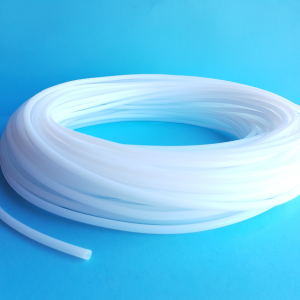>
> | The Secret of Successful Teflon Tube
Teflon tube (PTFE tube) is a thermoplastic, non-toxic and chemically inert material with excellent dimensional stability. It offers a wide range of applications in fluid transfer across various industries.
PTFE tube is used in a variety of industrial, electrical, medical and consumer applications due to its versatile properties. Letís take a closer look at some of the key characteristics that make it so versatile.
Flexibility
Teflon tube is a flexible polymer that can be used for a wide range of applications. It has a low coefficient of friction and is chemically inert.
It can be used to transfer fluids or solids. It can also be used for insulation and electrical protection.
A PTFE tube can be made in a variety of colors and thicknesses. It can also be shaped into custom shapes.
This is due to the fact that it has a high degree of flexibility.
Another advantage of PTFE is that it is naturally hydrophobic, which means that it wonít absorb water like some other materials do.
This makes PTFE a great material for applications that may get wet from time to time. Additionally, it is resistant to a variety of chemicals and acids. It can withstand very high and low temperatures as well, making it a versatile material.
 Durability
Teflon tube
Durability
Teflon tube is one of the most durable and non-stick materials available. It can be used in a wide range of different industries and is highly resistant to water.
PTFE is also known for its chemical resistance. This makes it a great choice for those who need to work with a variety of chemicals and solvents.
It can withstand temperatures as high as 260 degrees C and is thermally stable up to a temperature of -270 degrees C. It is also a good choice for medical devices because it has excellent lubricity and is biocompatible.
Corrosion Resistant
The corrosion resistance of Teflon tube allows it to withstand a variety of harsh chemicals. This makes it ideal for transporting a wide range of liquids and gases, including acids, alkalis and specialty gasses.
It also has a low friction coefficient that can help you achieve higher flow rates and easier washdown, eliminating process-contaminating residue. This makes it an excellent choice for industrial and chemical processing applications, as well as general laboratory, automotive, aerospace and insulation and food service.
It was invented in 1938 by Dupont and is known as PTFE (polytetrafluoroethylene). Its almost-inert properties make it resistant to nearly all industrial chemicals, and its temperature range of -60C to +250C opens up many potential applications. The material is also non-toxic, odourless and fire-retardant. Its low coefficient of friction also makes it a popular choice for nonstick cookware. It is also easy to clean and won't react to chemical fumes. It is the most popular fluoropolymer in use today.
Easy to Clean
A Teflon tube is the ideal choice for anyone who works with chemicals, whether youíre in the food or pharmaceutical industries. The synthetic polymer is not only resistant to a variety of chemicals but also abrasion-free. This type of tubing is available in standard sizes and lengths.
PTFE is a tad more expensive than your run-of-the mill polyurethane, but it lasts much longer. This tubing is also easier to clean and more environmentally friendly, thanks to its nonporous properties.
Fortunately, Coreflex has you covered with an extensive selection of the Teflon best of hoses in a variety of sizes and configurations. To top it off, we offer some of the best prices in the business. To find out more about the best of PTFE tube and to order yours, click here or give us a call at (888) 632-5238. We look forward to helping you pick the right one for your next project.
-- is one of the most durable and non-stick materials available. It can be used in a wide range of different industries and is highly resistant to water.
PTFE is also known for its chemical resistance. This makes it a great choice for those who need to work with a variety of chemicals and solvents.
It can withstand temperatures as high as 260 degrees C and is thermally stable up to a temperature of -270 degrees C. It is also a good choice for medical devices because it has excellent lubricity and is biocompatible.
Corrosion Resistant
The corrosion resistance of Teflon tube allows it to withstand a variety of harsh chemicals. This makes it ideal for transporting a wide range of liquids and gases, including acids, alkalis and specialty gasses.
It also has a low friction coefficient that can help you achieve higher flow rates and easier washdown, eliminating process-contaminating residue. This makes it an excellent choice for industrial and chemical processing applications, as well as general laboratory, automotive, aerospace and insulation and food service.
It was invented in 1938 by Dupont and is known as PTFE (polytetrafluoroethylene). Its almost-inert properties make it resistant to nearly all industrial chemicals, and its temperature range of -60C to +250C opens up many potential applications. The material is also non-toxic, odourless and fire-retardant. Its low coefficient of friction also makes it a popular choice for nonstick cookware. It is also easy to clean and won't react to chemical fumes. It is the most popular fluoropolymer in use today.
Easy to Clean
A Teflon tube is the ideal choice for anyone who works with chemicals, whether youíre in the food or pharmaceutical industries. The synthetic polymer is not only resistant to a variety of chemicals but also abrasion-free. This type of tubing is available in standard sizes and lengths.
PTFE is a tad more expensive than your run-of-the mill polyurethane, but it lasts much longer. This tubing is also easier to clean and more environmentally friendly, thanks to its nonporous properties.
Fortunately, Coreflex has you covered with an extensive selection of the Teflon best of hoses in a variety of sizes and configurations. To top it off, we offer some of the best prices in the business. To find out more about the best of PTFE tube and to order yours, click here or give us a call at (888) 632-5238. We look forward to helping you pick the right one for your next project.
--  Abdul Alim - 2023-02-18 Abdul Alim - 2023-02-18
Comments
<--[if supportLists]--> 1.<--[endif]--> The Secret of Successful Teflon Tube |

 Durability
Teflon tube
Durability
Teflon tube